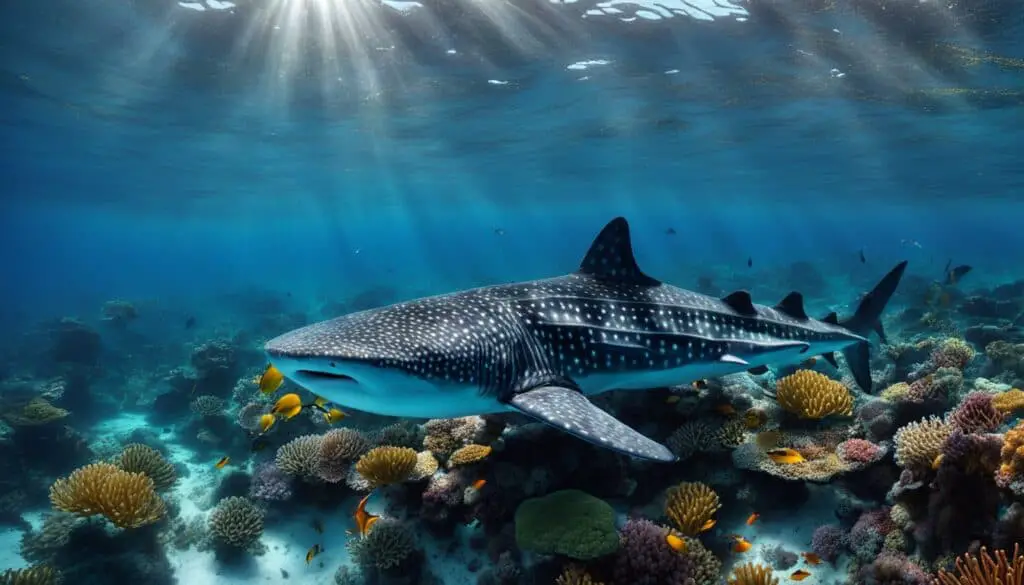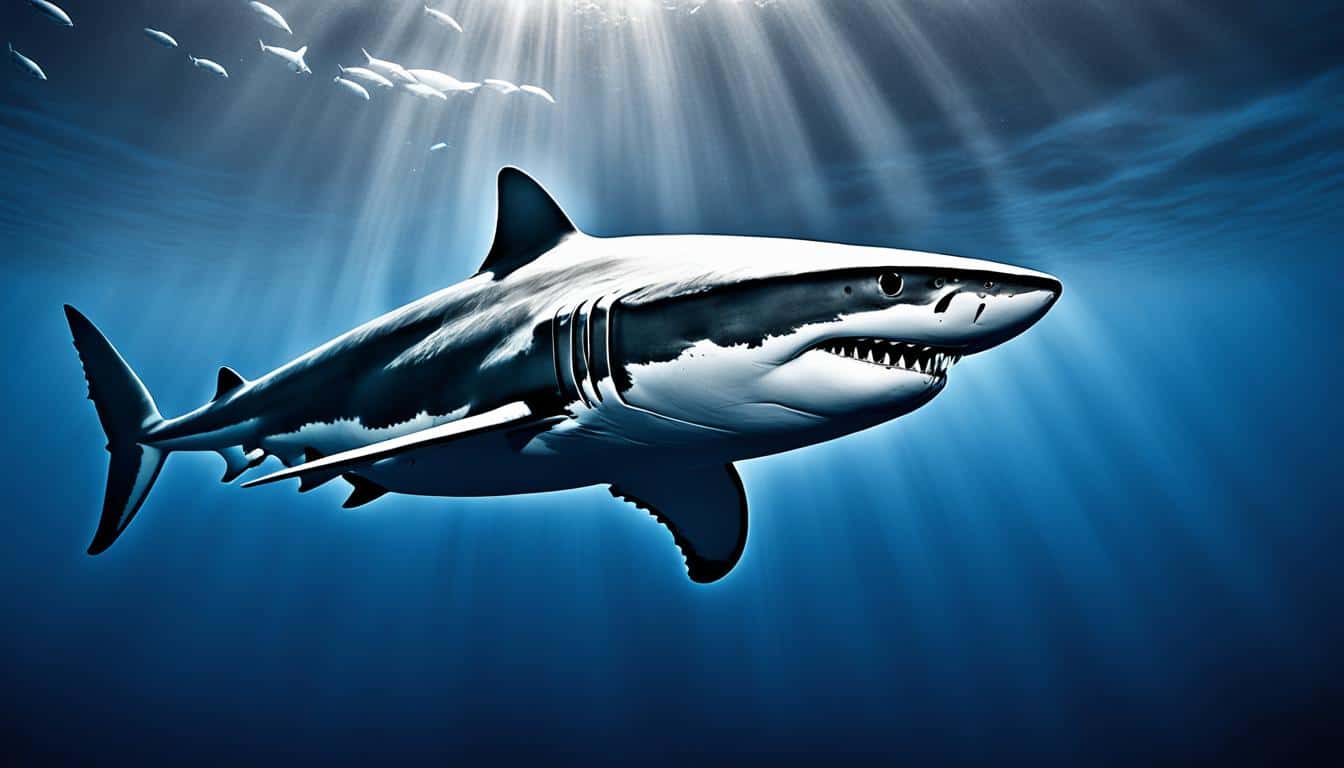Shark species are incredibly diverse, with over 536 recognized species. New discoveries are always being made. The whale shark is the largest fish in the sea, reaching lengths of 18.8 meters (nearly 62 feet). The basking shark is close behind, growing up to 12.27 meters (about 40 feet) long.
This article will take you on a journey through the fascinating world of giant shark species. We’ll explore their unique characteristics, habitats, and behaviors. We’ll also discuss the vital conservation efforts needed to protect these remarkable creatures.
Introduction to Shark Species
Sharks are fascinating and diverse creatures living in the world’s oceans. There are over 500 species, each with unique sizes, shapes, and roles in the ecosystem. From the tiny dwarf lanternshark to the huge whale shark, they amaze us with their variety. Learning about these fish helps us appreciate their importance in nature.
Sharks come in all sizes, from the small to the massive. This range shows their incredible adaptability. Some sharks are fierce hunters, while others, like the basking shark, eat plankton. This variety makes sharks truly interesting.
These giant shark species are crucial to their environments. They keep the ocean’s balance, affecting fish populations and ocean health. We must protect these amazing creatures as they face many threats in our changing oceans.
| Shark Species | Max Length (feet) | Diet Type |
|---|---|---|
| Whale Shark | 61 | Filter-Feeder |
| Basking Shark | 40 | Filter-Feeder |
| Great White Shark | 20 | Predator |
| Tiger Shark | 16 | Predator |
| Dwarf Lanternshark | 1.5 | Predator |
The Whale Shark: The Ultimate Marine Giant
The whale shark is a fascinating creature, the largest shark and fish in the world. It amazes people with its huge size and special traits. Learning about its size, home, and conservation status helps us understand its challenges in today’s oceans.
Size and Characteristics of the Whale Shark
The whale shark is huge, with an average length of 12 meters. Some can grow up to 18.8 meters, making it a giant. It has a patterned skin that looks like the stars in the sky. Despite its size, it eats plankton using a special filter-feeding system.
Whale Shark Habitat and Distribution
Whale sharks live in warm, tropical, and subtropical waters worldwide. They are often found in open oceans but sometimes near coasts during plankton blooms. They travel long distances to find the best food, which makes them vulnerable. They can be found from the Caribbean Sea to the Indian Ocean, showing their adaptability but also the need to protect their homes.

Conservation Status of Whale Sharks
Whale sharks are endangered, listed on the IUCN Red List. They face threats like bycatch, ship strikes, and damage to their homes. Conservation efforts include protecting their habitats, controlling fishing, and raising awareness. In places like the Philippines and Mexico, efforts are made to teach people about these important creatures.
Basking Sharks: The Second Largest Shark Species
Basking sharks are a key part of the ocean’s life as the second biggest sharks after the whale shark. It’s important to know about their size, behavior, and how we can protect them.
Physical Features and Size of Basking Sharks
Basking sharks can grow up to 12.27 meters (over 40 feet) long. They have a big, flat head and a wide mouth perfect for filter feeding. Their body shape and tail fin let them move smoothly through the water, making them stand out.
Behavior and Feeding Habits of Basking Sharks
These sharks feed by swimming with their mouths open, catching plankton and small fish. This shows how they play a key role in the ocean’s food chain. They also jump out of the water, which is a sight to see.
Threats and Conservation Efforts for Basking Sharks
Basking sharks are endangered due to fishing, getting caught in fishing gear, and losing their habitat. To help them, there are international protections, research, and working with fishermen for better fishing. These actions are crucial for their survival and the ocean’s balance.
What is the largest species of shark?
The whale shark is the biggest shark, often over 18.8 meters (62 feet) long. It’s huge but gentle, eating mostly plankton. People love to see these gentle giants in warm waters.
Basking sharks are also huge, up to 12 meters (39 feet) long. They eat by filtering food with their wide mouths open. These sharks show how diverse and complex ocean life is.
But, these sharks face threats like losing their homes and climate change. We need to protect them. Learning about these sharks helps us talk about saving our oceans for the future.
FAQ
What is the largest species of shark?
The whale shark (*Rhincodon typus*) is the biggest shark, reaching over 18.8 meters (62 feet) in length.
How does the whale shark compare in size to other giant shark species?
The whale shark is the largest shark. The basking shark can grow up to 12.27 meters (about 40 feet).
Where do whale sharks live?
Whale sharks live in warm tropical and subtropical oceans. They are found in open water and sometimes near coasts. They travel thousands of miles for food.
What do whale sharks eat?
Whale sharks eat plankton and small fish. They filter these from the water as they swim with their mouths open.
What threats do whale sharks face?
Whale sharks are endangered due to bycatch, ship strikes, and habitat damage.
What are basking sharks and how do they compare in size?
Basking sharks (*Cetorhinus maximus*) are the second-largest sharks. The largest can reach up to 12.27 meters (over 40 feet).
How do basking sharks feed?
Like whale sharks, basking sharks are filter feeders. They open their mouths to catch plankton and small fish from the water.
What conservation efforts are in place for giant shark species?
Conservation efforts include international protections, saving their habitats, fisheries rules, and awareness campaigns. These help protect whale sharks and basking sharks.
Are basking sharks endangered?
Yes, basking sharks are endangered. They face threats like fishing and losing their habitats.







